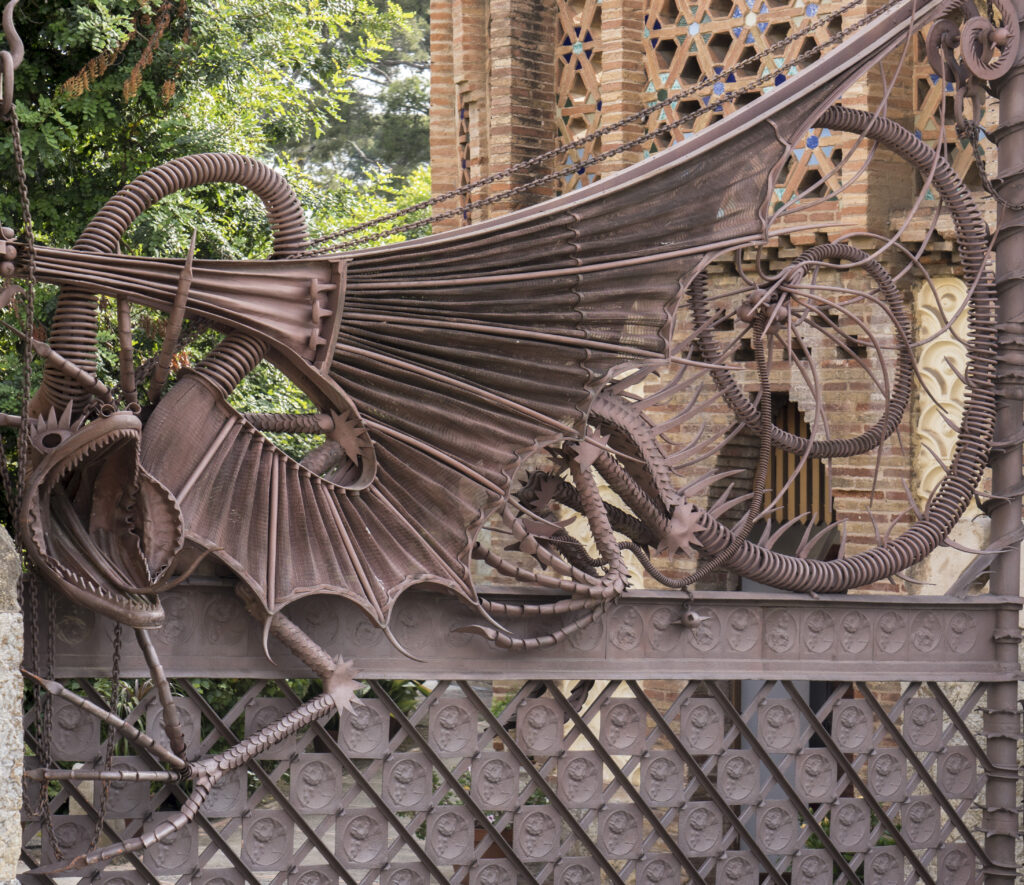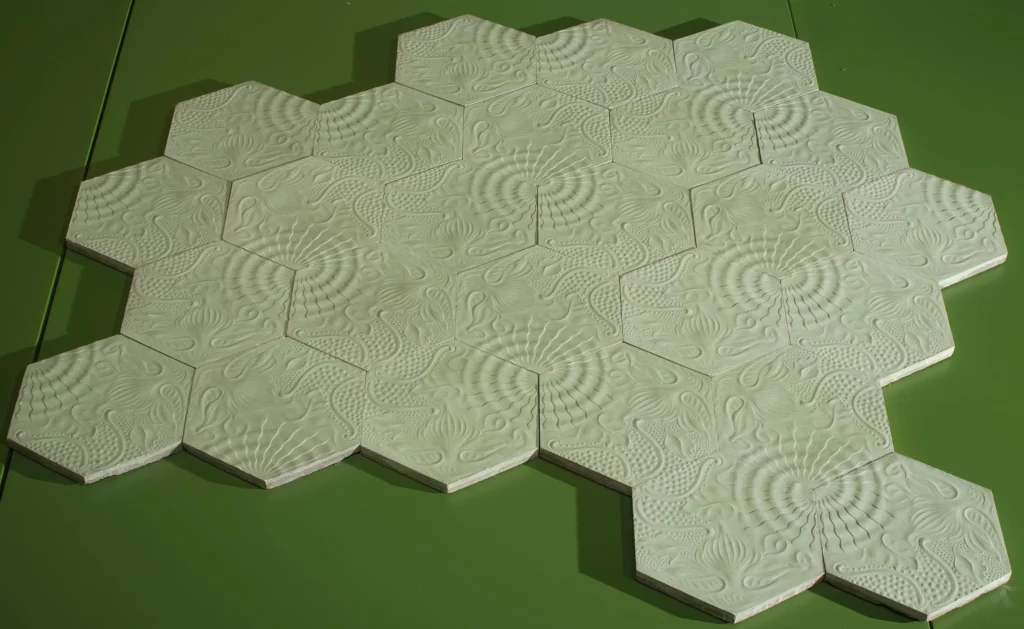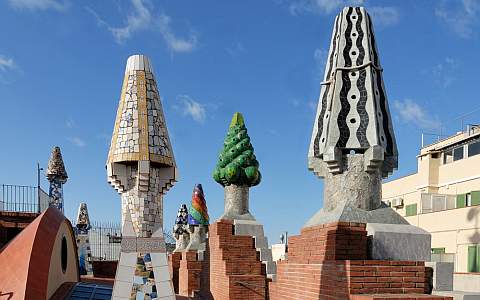Antoni Gaudí, the maverick architect from Catalonia, Spain, was not just a builder of structures; he was a conjurer of dreams. Born in 1852 in the quaint town of Reus, Gaudí displayed an early affinity for the arts. Antoni Gaudi artworks began at the School of Architecture in Barcelona, where he embraced a unique blend of academic rigor and creative exploration.
Gaudí’s family, deeply rooted in the Catalonian culture, provided the fertile ground for his imaginative pursuits. Little did anyone know that this visionary young artist would grow up to shape the cityscape of Barcelona with his spellbinding creations. As Gaudí navigated through his illustrious career, his groundbreaking designs, now collectively known as Antoni Gaudí artworks, would redefine the boundaries of architectural ingenuity and artistic expression.
1. The Dragon Gate at the Güell Pavilions

| Date of Completion | 1887-1888 |
| Dimensions | Well, it’s a gate, not a giant! |
| Location | Güell Pavilions, Barcelona |
Our adventure kicks off with a dragon. Yep, you heard it right—a dragon gate! Imagine entering a place through the jaws of a ceramic dragon. Gaudí nailed it with this one at the Güell Pavilions. It’s like the entrance to a fantasy land where dragons and architecture coexist in perfect harmony.
2. Casa Milà / La Pedrera at Night

| Date of Completion | 1912 |
| Dimensions | Big enough to make you go “Wow!” |
| Location | Passeig de Gràcia, Barcelona |
Now, picture this: Casa Milà, also known as La Pedrera, all lit up like a fairytale castle at night. Gaudí turned a regular building into a nighttime spectacle. It’s like the Cinderella of architecture, but way cooler and less glass slipper, more avant-garde charm.
3. Casa Vicens, Barcelona

| Date of Completion | 1885-1889 |
| Dimensions | Perfect for a cozy abode |
| Location | Carrer de les Carolines, Barcelona |
Casa Vicens is like Gaudí’s first masterpiece to architecture. Completed in 1889, it’s a house that says, “Hey world, get a load of my mix of Moorish and Gothic vibes!” If houses could flirt, Casa Vicens would be batting its eyelashes at you.
4. Sillón Calvet

| Date of Completion | 1902 |
| Dimensions | Comfy enough for a catnap |
| Location | In some lucky person’s living room, probably |
Now, let’s take a seat—literally. Gaudí wasn’t just about buildings; he dabbled in furniture too. The Sillón Calvet is like the rockstar of chairs. It’s got those curves and twists that make you go, “Is it furniture or a work of art?” Spoiler alert: it’s both!
5. Palau Güell, Barcelona

| Date of Completion | 1890-1895 |
| Dimensions | Gaudí-sized big |
| Location | Carrer Nou de la Rambla, Barcelona |
Palau Güell is Gaudí’s version of a mansion on steroids. Completed between 1890 and 1895, it’s like a candy store for your eyes. The facade alone is a carnival of colors and shapes, leaving you wondering if you stumbled into a building or an art gallery.
6. Floor Tiles for Casa Milà: Octopus, Snail, and Starfish

| Date of Completion | 1910-1912 |
| Dimensions | Tile-sized, obviously |
| Location | Passeig de Gràcia, Barcelona |
Let’s take a look down—way down. Gaudí didn’t just stop at buildings; he jazzed up the sidewalks too. The floor tiles at Casa Milà are like an underwater wonderland. Octopuses, snails, and starfish, oh my! It’s like walking on the ocean floor, but in the middle of the city.
7. Two-Seat Sofa

| Date of Completion | 1906-1910 |
| Dimensions | Cozy for two, or one sprawled out |
| Location | Somewhere, enjoying its well-deserved break |
Who said architects can’t do furniture? Gaudí proved them wrong with his two-seat sofa. Crafted between 1906 and 1910, it’s not just a place to park your behind; it’s a statement. Imagine inviting someone over and dropping the casual, “Oh, that sofa? Gaudí designed it. No biggie.”
8. Casa Batlló, Barcelona, Spain

| Date of Completion | 1904-1906 |
| Dimensions | Big enough to turn heads |
| Location | Passeig de Gràcia, Barcelona |
If buildings could win beauty pageants, Casa Batlló would be Miss Universe. Completed between 1904 and 1906, it’s like Gaudí took a regular house and melted it, twisted it, and turned it into a fairytale palace. It’s so stunning; you might catch yourself doing a double-take every time you walk by.
9. The Roof of Palau Güell, Barcelona

| Date of Completion | 1890-1895 |
| Dimensions | Sky’s the limit |
| Location | Carrer Nou de la Rambla, Barcelona |
Let’s take it to the top—literally. The rooftop of Palau Güell is like Gaudí’s secret garden in the sky. Completed alongside the mansion between 1890 and 1895, it’s a surreal landscape of chimneys that look like they’re marching off to their own beat. It’s like Gaudí threw a rooftop party, and you’re invited.
10. Vitrina Comella

| Date of Completion | 1901-1902 |
| Dimensions | Just the right size to showcase cool stuff |
| Location | Probably holding treasures somewhere fancy |
Ever seen a glass cabinet that’s a work of art? Well, you have now. The Vitrina Comella is like Gaudí saying, “Why should furniture be boring?” Completed between 1901 and 1902, it’s like a mini-museum right in your living room. Just imagine showing off your favorite knick-knacks in that beauty!
11. Two-Leafed Gate from Casa Vicens

| Date of Completion | 1883-1888 |
| Dimensions | Gate-sized |
| Location | Carrer de les Carolines, Barcelona |
Now, let’s swing open the gates to Casa Vicens—literally. The two-leafed gate is like Gaudí’s way of saying, “Welcome to my masterpiece.” Crafted between 1883 and 1888, it’s not your average gate. It’s like an artistic sneak peek into the wonderland that is Casa Vicens.
12. Corner Display Cabinet

| Date of Completion | 1906 |
| Dimensions | Not specified (display cabinet) |
| Location | Private collections and museums |
Gaudí’s Corner Display Cabinet seamlessly blends form and function. Its organic lines and meticulous craftsmanship make it a captivating piece that transcends its utilitarian purpose.
13. Upright Chair

| Date of Completion | 1901 |
| Dimensions | Chair-sized |
| Location | Somewhere, waiting for you to take a seat |
Last but not least, let’s talk about sitting pretty. Gaudí’s Upright Chair is like a stylish friend in your living room. Crafted in 1901, it’s not just a chair; it’s a conversation starter. You sit down, and people can’t help but ask, “Where did you get that? It’s so Gaudí!”
Frequently Asked Questions
What is Antoni Gaudi’s art style?
In addition to Neo-Gothic art and Oriental techniques, Gaudi’s style was influenced by Art Nouveau architecture’s ornamental approach, which resulted in ornate and extravagant designs. Gaudi was passionate about architecture, nature, and religion.
What are the key features of Antoni Gaudí?
The architect Antoni Gaudí, who originated from Catalonia, is known for his unique style that combines organic unity, rich colors and textures, and freedom of form.
What makes Gaudí so special?
Antoni Gaudí had a major role in catalan architecture’s rise to international recognition. Along with being an architect and designer, Gaudí was also a daring technical innovator with a unique capacity to synthesize his own tradition. He knew how to incorporate artistic and practical components into his structures.
Conclusion
So, there you have it—Gaudí’s playful parade of 13 masterpieces that redefine what art and architecture can be. From dragons at the gate to sofas that are practically celebrities, Gaudí artworks are a testament to his wild imagination and incredible talent. The next time you find yourself in Barcelona, make sure to take a stroll through Gaudí’s wonderland. Who knows, you might just catch a glimpse of a dragon or find yourself sitting on a Gaudí-designed sofa, wondering how furniture got so fabulous!












